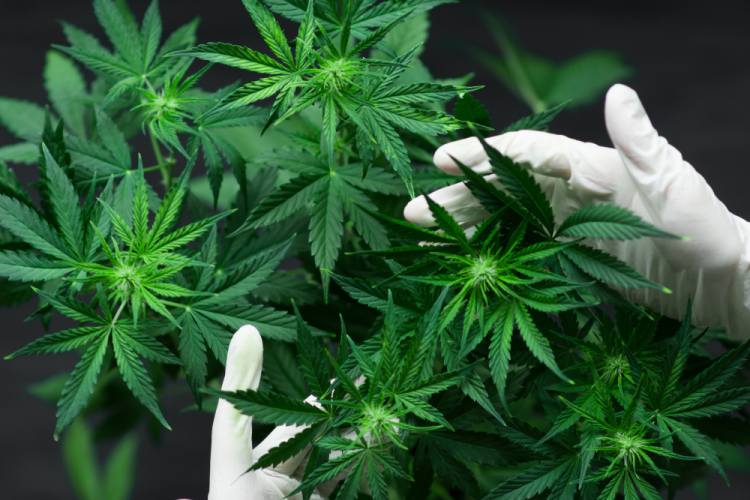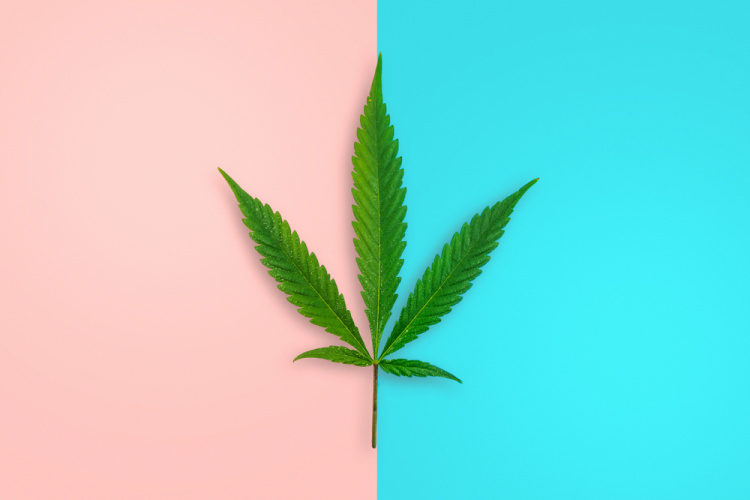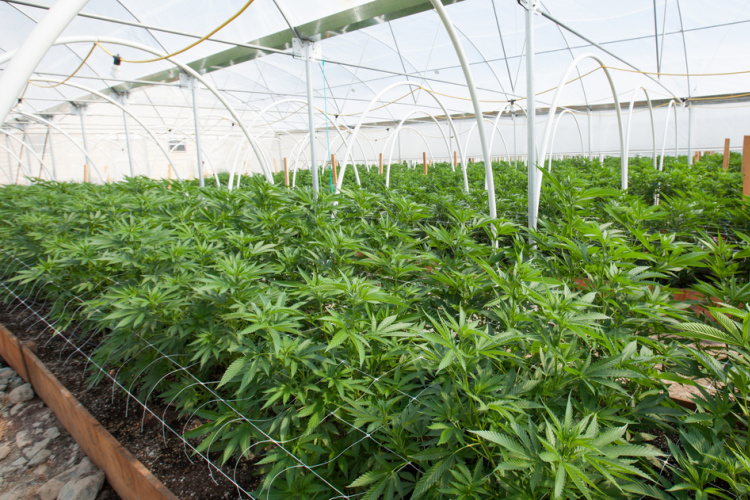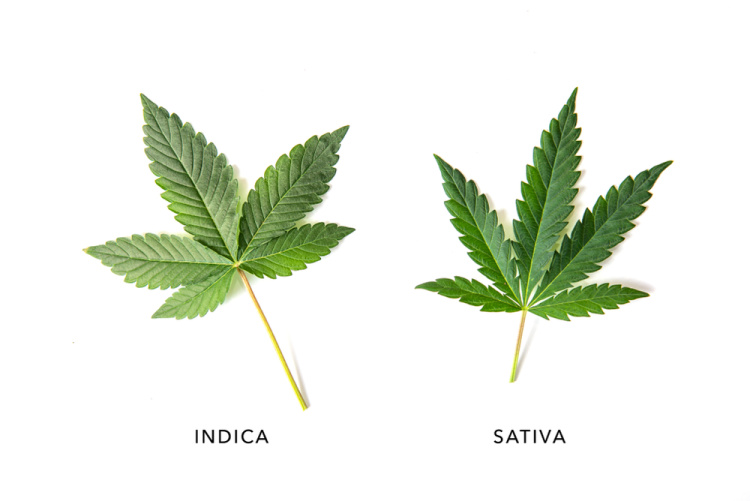At Green Goods, we focus a lot of attention on the various compounds produced by the cannabis plant, such as the cannabinoids and terpenes that make cannabis such a uniquely effective medicine. But one thing we haven’t spent as much time delving into is the source of all those potent medicines: the marijuana plant itself.
In today’s post, we’d like to offer a guided tour of the cannabis plant anatomy and life cycle. By the end, you should have a crystal-clear understanding of how the marijuana plant grows from a tiny seed into a virtual medicine factory.
Male and Female Marijuanas Plants: An Introduction

You probably know that the cannabis plant is a complex living structure that goes through several life stages before it can be harvested for the flower (or “buds”) we know and love. What may come as more of a surprise is that a given marijuana plant has a gender: It’s either male or female!
This makes the cannabis plant something of an outlier. While most flowering plants include both male and female sex organs, cannabis plants are gendered. This presents growers with a conundrum: While both genders are required for pollination, only female plants are actually used to grow cannabis. The female plant is the only one that develops the resinous, trichome-covered buds that you’ll find on dispensary shelves.
Instead of developing buds, male plants develop structures called “pollination pods” that are capable of pollinating any female plants in the vicinity. However, once those female plants have been fertilized, they turn their energy away from growing the potent and resinous buds. That’s why growers are careful to remove any male plants from their grow rooms before they have a chance to alter female plant production.
In the wild, of course, it’s in the plant’s interest to pollinate and thus reproduce, propagating the species. That’s why the marijuana plant has a last-ditch option when it comes to fertilization: It can actually become a hermaphrodite, meaning it has both male and female sex organs. This typically occurs when the plant is experiencing stress due to poor growing conditions or other environmental factors. And while it may be frustrating to growers, you have to admit it’s a pretty neat trick!
The Difference Between Male and Female Marijuana Plants: Cannabis Anatomy

In many regards, the cannabis plant isn’t terribly unique. Once its little round seeds are germinated, they’ll send a skinny taproot down into the soil. That initial taproot will develop into a complex network designed to draw up water from the ground. It soon sprouts leaves covered in tiny pores called stomas, which take in carbon dioxide (CO2) and expel oxygen (O2).
Male and female cannabis plants can be distinguished by their sex organs—female stigma and male pollen sacs—that develop between the plant’s nodes, or points where branches sprout from the central stem. The males will have round pollen sacs here, whereas females will have tiny hairlike pistils.
But because it’s the unpollinated female plants that produce the medicinal compounds we’re most interested in, we’ll end our discussion of male marijuana plant anatomy here (sorry, guys!).
The Flower: A Miniature Medicine Factory

Now we’ve come to where the action is, medicinally speaking. The female flower, more than being a single structure, is part of a complex system of plant parts that all work together. Their goal? To create a rich and healthy output of cannabinoids, terpenes, and other active compounds. Here are the essential players in cannabis anatomy:
Flower: Because these plant structures are chock-full of beneficial cannabinoids and terpenes, they can be thought of as the principal “product” of the marijuana plant. In the healthiest plants, the flower is typically dense, tightly packed, and covered with a frosty-looking coating of trichomes.
Trichomes: If you observe the coating on healthy flower with a magnifying lens, you’ll see that the frosty-looking coating is actually made up of trichomes: miniscule, clear, mushroom-shaped glands. These tiny glands do the heavy lifting of the cannabis plant, producing aromatic terpenes (mainly to repel pests) as well as cannabinoids including THC, CBD, CBN, CBG, and others still. The ancient cannabis concentrates hash and kief are made solely from these potent, resinous glands.
Cola: Sometimes known as a “bud site,” these structures are clusters of flowers growing tightly together. They typically appear near the top of the plant.
Sugar leaf: These resin-coated leaves are what cannabis flowers form around. They’re often used to produce pre-rolls, concentrates and other high-potency products.
Bract: Similar to sugar leaves, bracts are green teardrop-shaped leaves that surround the cannabis plant’s female reproductive organs. While they’re less plentiful than flowers, bracts actually contain the cannabis plant’s highest concentration of cannabinoids.
Different Parts of the Cannabis Plant: Structural Support
Thus far we’ve focused most of our attention on the all-important flower, but they’re not the end of the story! Other marijuana plant structures include:
- Stems: Necessary in order to provide structure for the plant. Apart from the main stem that holds a plant upright, smaller “leaf stems” grow outwards to provide structure to the leaves that develop elsewhere.
- Nodes: The spot where a leaf stem meets the main stem is called a node.
- Leaves: Marijuana plant leaves don’t contain anywhere near the same level of cannabinoids or terpenes as flower, though they still have their uses, such as being used to make hash.
Growth Stages of the Cannabis Plant
A cannabis plant goes through several growth stages before it can finally be harvested and prepared for consumption. There are four main stages in a cannabis plant’s life:
- Germination (5–10 days): During this crucial phase, the seed is planted and supplied with water and light in order to get it to ‘pop’ and begin sprouting a viable plant.
- Seedling (2–3 weeks): This phase is when the tiny sprout begins to develop leaves with full blades, making it look more like an actual cannabis plant than just a sprouted seed.
- Vegetative (3–16 weeks): This is when the plant’s growth really takes off. The marijuana plant will begin growing in height and developing new stems, branches, and leaves.
- Flowering (8–11 weeks): Last but not least comes the flowering stage where cannabis plants begin to grow the colas and resinous buds that they are prized for.
Want to know (and watch!) more about this fascinating cycle? Tune into our Green Goods Live Flower Webcam and watch the grass grow!
What Does a Marijuana Plant Look Like? The Differences Between Indica And Sativa

A cannabis plant can take one of two basic shapes, depending on the given type of marijuana. That’s because while all cannabis plants have the same anatomical parts, not all plants contain the same genetics. Depending on their genetic makeup, plants are typically classified as being either sativa or indica, or a hybrid of the two. Hint: You can learn more about these and other cannabis terms here.
There are several visual differences between indicas and sativas. Typically, a sativa cannabis plant tends to grow tall and lanky. As they can reach heights of 20 feet, sativa plants are often called trees. Compared with indica plants, their leaves are thinner-bladed and spaced farther apart from each other.
By comparison, indica plants are usually called bushes owing to their shorter, squatter profiles. They typically reach a height between 3 – 6 feet. Compared with sativa plants, their leaves are broader, often darker, and tend to be more closely spaced. Because they can grow so densely, indicas typically produce more cannabis buds by weight than their sativa counterparts.
Additionally, sativas also tend to have a longer flowering time than indica plants. While most indicas flower within 8–9 weeks, sativas can take anywhere from 10–16 months to complete their flowering stage.
Cannabis Plant Anatomy: Wrapping Up
We hope you’ve enjoyed reading this guide to the marijuana plant as much as we’ve enjoyed creating it! If you’re interested in trying out some of the finished products for yourself, start by choosing your location, then check the online menu to see what’s currently in stock. We look forward to seeing you!
